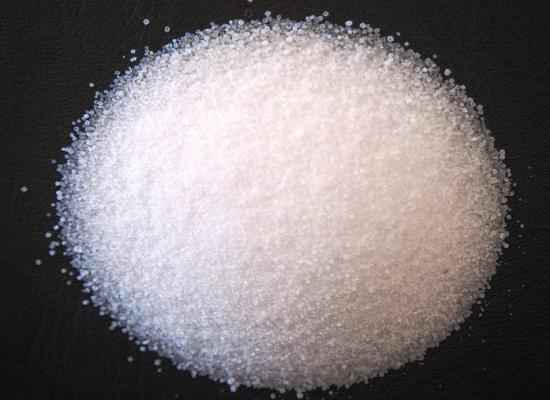Hydroxylamine Sulfate: Unique Biological Effects and Toxicity Mechanisms Explored
General Description
Hydroxylamine sulfate is widely used in organic synthesis but is known for its unique biological effects. It rapidly induces methemoglobinemia, causing abnormal hemoglobin production and various systemic disorders. The mechanisms underlying these effects are not fully understood, but reactive oxygen species and free blood iron may play a role. Treatment options, such as methylene blue antidote, need further exploration. Exposure to hydroxylamine sulfate also leads to the formation of Hb-NO complex, impairing oxygen transport function. Distinct differences in the mechanisms of hemoglobin interaction with nitric oxides and hydroxylamine sulfate have been observed, highlighting the need for specific treatment strategies. Methylene blue may be effective in reducing methemoglobin levels.

Figure 1. Hydroxylamine sulfate
Introduction to the Toxicity and Biological Effects
Hydroxylamine sulfate is widely used as an intermediate in the synthesis of various organic compounds, including pharmaceuticals, pesticides, dyes, and caprolactam. Along with its parent compound, hydroxylamine, it is known for its unique biological effects and has attracted the attention of many researchers. One significant aspect that sets Hydroxylamine and Hydroxylamine sulfate apart from other xenobiotics is their ability to rapidly induce methemoglobinemia, a condition characterized by the production of an abnormal form of hemoglobin. This toxic methemoglobinemia not only leads to hemolytic anemia but also causes sulfohemoglobinemia and various systemic disorders. Despite extensive research, the mechanisms underlying the development of toxic methemoglobinemia and hemolytic anemia due to Hydroxylamine and Hydroxylamine sulfate intoxication remain incompletely understood. The involvement of reactive oxygen species, nitric oxide, and free blood iron in the formation of hemo- and cytotoxic effects needs further investigation. Additionally, the persistent metabolic hypoxia and systemic disorders observed even after the reduction of methemoglobin levels and regeneration of normal hemoglobin levels require clarification. The effectiveness of potential treatments, such as the methylene blue antidote and a-tocopherol acetate, for hydroxylamine sulfate poisoning remains unexplored. Therefore, it is essential to address these issues and gain a better understanding of the mechanisms involved in order to develop approved diagnostic methods and effective clinical protocols for the treatment of Hydroxylamine and Hydroxylamine sulfate intoxications. 1
Methemoglobin Formation and Hb-NO Complex in Hydroxylamine Sulfate Poisoning
The toxicity of hydroxylamine sulfate and its effect on blood hemoglobin (Hb) have been investigated in animal models. The results obtained using the Electron Spin Resonance (ESR) spectroscopy method showed that exposure to hydroxylamine sulfate led to a significant increase in methemoglobin (MetHb) levels, which exceeded 50% of total Hb in blood within 30 minutes of exposure. Furthermore, a high anisotropic singlet signal with triplet fine splitting, identified as the Hb–NO complex, was observed in the blood of exposed animals. This complex is known to impair oxygen transport function due to the covalent bond formed with Hb. The level of Hb–NO complex decreased only by 10 times in 24 hours after exposure, indicating a persistent metabolic hypoxia and systemic disorder. In contrast, the MetHb level returned to normalcy in 24 hours after exposure. The experimental animals also exhibited severe cyanosis of extremities, rapid breathing and heart rate, hypodynamia, and movement discoordination. These symptoms persisted for up to 24 hours after exposure, likely due to the presence of a large amount of Hb–NO in blood. The findings suggest that the Hb–NO complex may play a significant role in the mechanism of acute poisoning by hydroxylamine sulfate. 2
Mechanisms of Hemoglobin Interaction in Hydroxylamine Sulfate Poisoning
In the investigation of methylene blue efficacy in cases of acute poisoning caused by hydroxylamine sulfate, it is found that there are distinct differences in the mechanisms of hemoglobin interaction with nitric oxides and hydroxylamine sulfate. Comparing to sodium nitrite poisoning, where a more intense Electron Spin Resonance (ESR) signal for the Hb–NO complex is observed in liver tissue, hydroxylamine sulfate exposure shows different effects. When exposed to hydroxylamine sulfate, the ESR signal of the Mo7+ center, which is typical for xanthine oxidase, rapidly increases and remains elevated for 24 hours. This suggests an increase in oxidative stress and a weakening of antioxidant protection, as indicated by a reduction in superoxide dismutase and ceruloplasmin levels. Furthermore, reactive oxygen species formation is observed, indicating oxidative damage. Both sodium nitrite and hydroxylamine sulfate lead to an increase in methemoglobin and hemoglobin nitrosyl levels. However, the mechanisms underlying these increases differ between the two substances. These findings highlight the need for specific treatment strategies in cases of acute poisoning caused by hydroxylamine sulfate. Methylene blue, a commonly used antidote for methemoglobinemia, may be effective in these cases by reducing methemoglobin levels and restoring normal hemoglobin function. 2
Reference
1. Lim HC, Tan HH. International perspective from singapore on "methemoglobinemia and sulfhemoglobinemia in two pediatric patients after ingestion of hydroxylamine sulfate". West J Emerg Med. 2009;10(3):202.
2. Prodanchuk MG, Tsatsakis AM, Prodanchuk GM, Tsakalof AK. Investigation of in vivo toxicity of hydroxylamine sulfate and the efficiency of intoxication treatment by α-tocopherol acetate and methylene blue. Food Chem Toxicol. 2013;61:227-232.
Related articles And Qustion
Lastest Price from Hydroxylamine sulfate manufacturers

US $1.00/KG2025-04-21
- CAS:
- 10039-54-0
- Min. Order:
- 1KG
- Purity:
- 99%
- Supply Ability:
- 10 mt

US $3560.00/T2025-03-26
- CAS:
- 10039-54-0
- Min. Order:
- 1T
- Purity:
- 98%
- Supply Ability:
- 1-100mt



